Fatigue Life of RC Bridge Decks Affected by Non-Uniformly Dispersed Stagnant Water
Abstract
:Featured Application
Abstract
1. Introduction
2. Methodology for Predicting the Remaining Fatigue Life
- Ground penetrating radar is installed on a vehicle that runs about 80 km/h over the bridge, where signal responses of the hidden information of RC decks below the pavement layers are detected [22].
- These signals are processed to achieve sound locations of the water especially at the upper surface layer of RC decks.
- These wetting locations are induced into the finite element model by utilizing the multi-scale simulation program.
- Travelling wheel load is applied until the failure of RC decks based on a failure criterion that will be stated in a later section.
- Finally, remaining fatigue life of RC decks is computed.
3. Specifications for the Parametric Study
3.1. Referential Reinforced Concrete Deck
3.2. Material Properties
3.3. Wheel-Type Moving Load
3.4. Failure Criterion
3.5. Numerical Model
4. Dry and Wet Ambient Conditions
5. Case Study
6. Hazard Map for Engineering Practice
7. Predictive Correlation
8. Conclusions
- The patterns of wet and dry areas have a great influence on the remaining fatigue life of the RC decks.
- It is found that the central zone of the wheel-loading path is the wetting location of higher risk on the fatigue life.
- The negative impacts of stagnant water reduce gradually as the wetting locations go farther from the central zone of the wheel-loading path, where these impacts tend to significantly reduce at the sides of the RC deck away from the wheel-loading path.
- A hazard map for the wetting locations of higher risk is proposed based on the simulation results, which is beneficial for bridges’ inspectors.
- A predictive correlation is proposed for fatigue life prediction of RC deck based on site inspected wetting locations with high accuracy, which fulfill the engineers’ needs to conduct the risk assessment of RC decks during maintenance.
Author Contributions
Funding
Acknowledgments
Conflicts of Interest
References
- Val, D.V.; Stewart, M.G.; Melchers, R.E. Effect of reinforcement corrosion on reliability of highway bridges. Eng. Struct. 1998, 20, 1010–1019. [Google Scholar] [CrossRef]
- Vassie, P. Reinforcement corrosion and the durability of concrete bridges. In Proceedings of Institution of Civil Engineers; Institution of Civil Engineers: London, UK, 1984; Part 1; Volume 76. [Google Scholar]
- Cady, P.D.; Weyers, R.E. Chloride penetration and the deterioration of concrete bridge decks. Cem. Concr. Aggreg. 1983, 5, 81–87. [Google Scholar]
- Freyermuth, C.L.; Klieger, P.; Stark, D.C.; Wenke, H.N. Durability of concrete bridge decks—A review of cooperative studies. Highw. Res. Rec. 1970, 328, 50–60. [Google Scholar]
- Lindquist, W.D.; Darwin, D.; Browning, J.; Miller, G.G. Effect of Cracking on Chloride Content in Concrete Bridge Decks; American Concrete Institute: Farmington Hills, MI, USA, 2006. [Google Scholar]
- Shah, S.P.; Weiss, W.J.; Yang, W. Shrinkage Cracking—Can It Be Prevented? Concr. Int. 1998, 20, 51–55. [Google Scholar]
- Sakulich, A.R.; Bentz, D.P. Increasing the service life of bridge decks by incorporating phase-change materials to reduce freeze-thaw cycles. J. Mater. Civ. Eng. 2011, 24, 1034–1042. [Google Scholar] [CrossRef]
- Detwiler, R.J.; Kojundic, T.; Fidjestol, P. Evaluation of bridge deck overlays. Concr. Int. Detroit 1997, 19, 43–46. [Google Scholar]
- Ulm, F.J.; Coussy, O.; Kefei, L.; Larive, C. Thermo-chemo-mechanics of ASR expansion in concrete structures. J. Eng. Mech. 2000, 126, 233–242. [Google Scholar] [CrossRef]
- Perdikaris, P.C.; Beim, S. RC Bridge Decks Under Pulsating and Moving Load. ASCE J. Struct. Eng. 1988, 114, 591–607. [Google Scholar] [CrossRef]
- Poston, R.W.; Carrasquillo, R.L.; Breen, J.E. Durability of post-tensioned bridge decks. Mater. J. 1987, 84, 315–326. [Google Scholar]
- Matsui, S. Fatigue Strength of RC-Slabs of Highway Bridge by Wheel Running Machine and Influence of Water on Fatigue. In Proceedings of Japan Concrete Institute; Japan Concrete Institute: Tokyo, Japan, 1987; Volume 9, pp. 627–632. [Google Scholar]
- Matsui, S. Lifetime prediction of bridge. J. Jpn. Soc. Civ. Eng. 1996, 30, 432–440. [Google Scholar]
- Waagaard, K. Fatigue strength evaluation of offshore concrete structures. ACI-SP 1982, 75, 373–397. [Google Scholar]
- Fujino, Y. Infrastructure Maintenance Renovation and Management, Cross-Ministerial Strategic Innovation Promotion Program. 2017. Available online: http://www.jst.go.jp/sip/dl/k07/pamphlet_2017_en.pdf (accessed on 17 May 2018).
- Otsu, K. The current situation and maintenance of expressways in Japan. In Proceedings of the 3rd International Conference on Sustainable Construction Materials and Technology, Kyoto, Japan, 18–21 August 2013. [Google Scholar]
- Fathalla, E.; Tanaka, Y.; Maekawa, K.; Sakurai, A. Quantitative deterioration assessment of road bridge decks based on site inspected cracks under stagnant water. J. Adv. Concr. Technol. 2019, 17, 16–33. [Google Scholar] [CrossRef]
- Solwik, V.; Saouma, E.V. Water pressure in propagating concrete cracks. J. Struct. Eng. Am. Soc. Civ. Eng. 2000, 126, 235–242. [Google Scholar] [CrossRef]
- Biot, M.A. General theory of three-dimensional consolidation. J. Appl. Phys. 1941, 12, 155–164. [Google Scholar] [CrossRef]
- Maekawa, K.; Fujiyama, C. Crack water interaction and fatigue life assessment of RC bridge decks. In Proceedings of the Poromechanics V: American Society of Civil Engineers, Vienna, Austria, 10–12 July 2013; pp. 2280–2289. [Google Scholar]
- Maekawa, K.; Ishida, T.; Chijiwa, N.; Fujiyama, C. Multiscale coupled-hygromechanistic approach to the life-cycle performance assessment of structural concrete. J. Mater. Civ. Eng. Am. Soc. Civ. Eng. 2015, 27, A4014003. [Google Scholar] [CrossRef]
- Mizutani, T.; Nakamura, N.; Yamaguchi, T.; Tarumi, M.; Hara, I. Bridge slab damage detection by signal processing of uhf-band ground penetrating radar data. J. Disaster Res. 2017, 12, 415–421. [Google Scholar] [CrossRef]
- Powers, T.C. A working hypothesis for further studies of frost resistance of concrete. J. Proc. 1945, 41, 245–272. [Google Scholar]
- El-Kashif, K.F.; Maekawa, K. Cyclic cumulative damaging of reinforced concrete in post-peak regions. J. Adv. Concr. Technol. 2004, 2, 257–271. [Google Scholar]
- Amini, F.; Sama, K.M. Behavior of stratified sand–silt–gravel composites under seismic liquefaction conditions. Soil Dyn. Earthq. Eng. 1999, 18, 445–455. [Google Scholar] [CrossRef]
- Fathalla, E.; Tanaka, Y.; Maekawa, K. Remaining fatigue life assessment of in-service road bridge decks based upon artificial neural networks. Eng. Struct. 2018, 171, 602–616. [Google Scholar] [CrossRef]
- Japan Road Association. Specification for Highway Bridges-Part III Concrete Bridges; Japan Road Association: Tokyo, Japan, 2012. [Google Scholar]
- Maeshima, T.; Koda, Y.; Tsuchiya, S.; Iwaki, I. Influence of corrosion of rebars caused by chloride induced deterioration on fatigue resistance in RC road deck. J. Jpn. Soc. Civ. Eng. 2014, 70, 208–225. [Google Scholar]
- Tanaka, Y.; Maekawa, K.; Maeshima, T.; Iwaki, I.; Nishida, T.; Shiotani, T. Data assimilation for fatigue life assessment of RC bridge decks coupled with hygro-mechanistic model and nondestructive inspection. J. Disaster Res. 2017, 12, 422–431. [Google Scholar] [CrossRef]
- Matsui, S.; Maeda, Y. A rational valuation method for deterioration of highway bridge decks. J. Jpn. Soc. Civ. Eng. 1986, 374, 419–426. [Google Scholar]
- Fathalla, E.; Tanaka, Y.; Maekawa, K.; Sakurai, A. Quantitative deterioration assessment of road bridge decks based on site inspected cracks. Appl. Sci. 2018, 8, 1197. [Google Scholar] [CrossRef]
- Kakuma, K.; Sato, K.; Nishi, H. Field survey on the detection of stagnant water on highway bridge RC slabs using electromagnetic wave radar method. In Proceedings of the Hokkaido Chapter of JSCE, Sapporo, Japan, 4–5 February 2017; Volume 73, p. A-36. [Google Scholar]
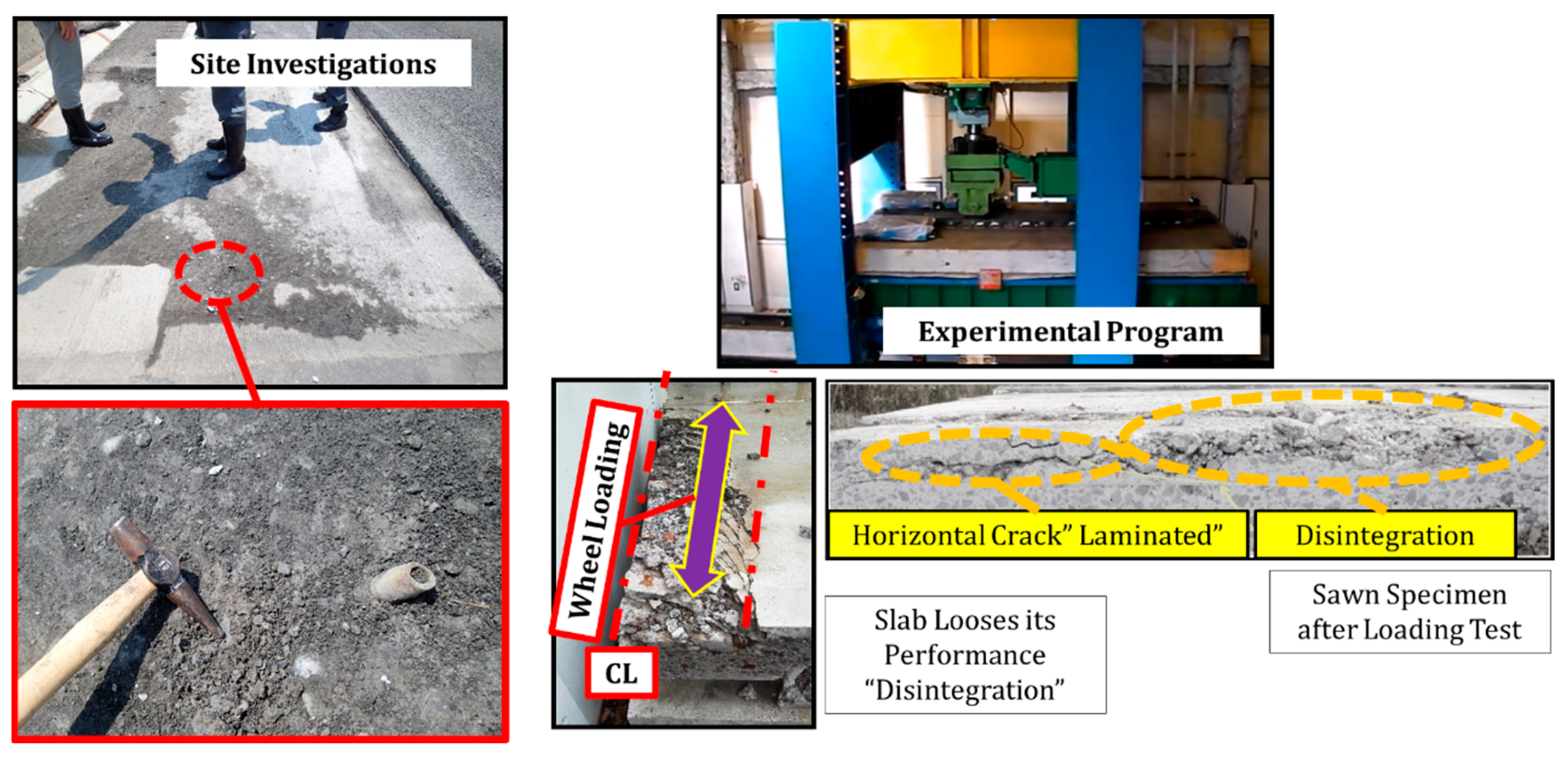
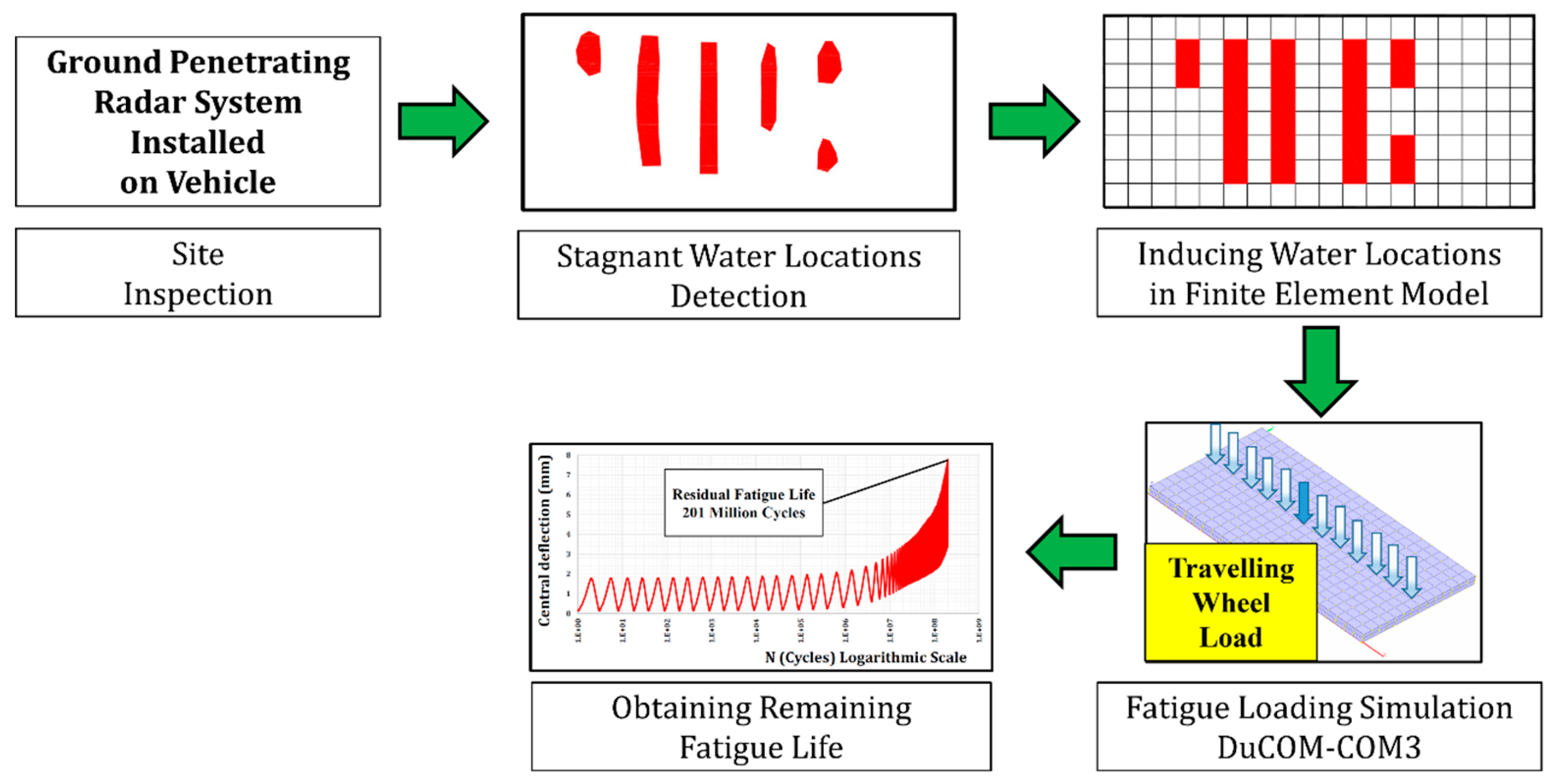
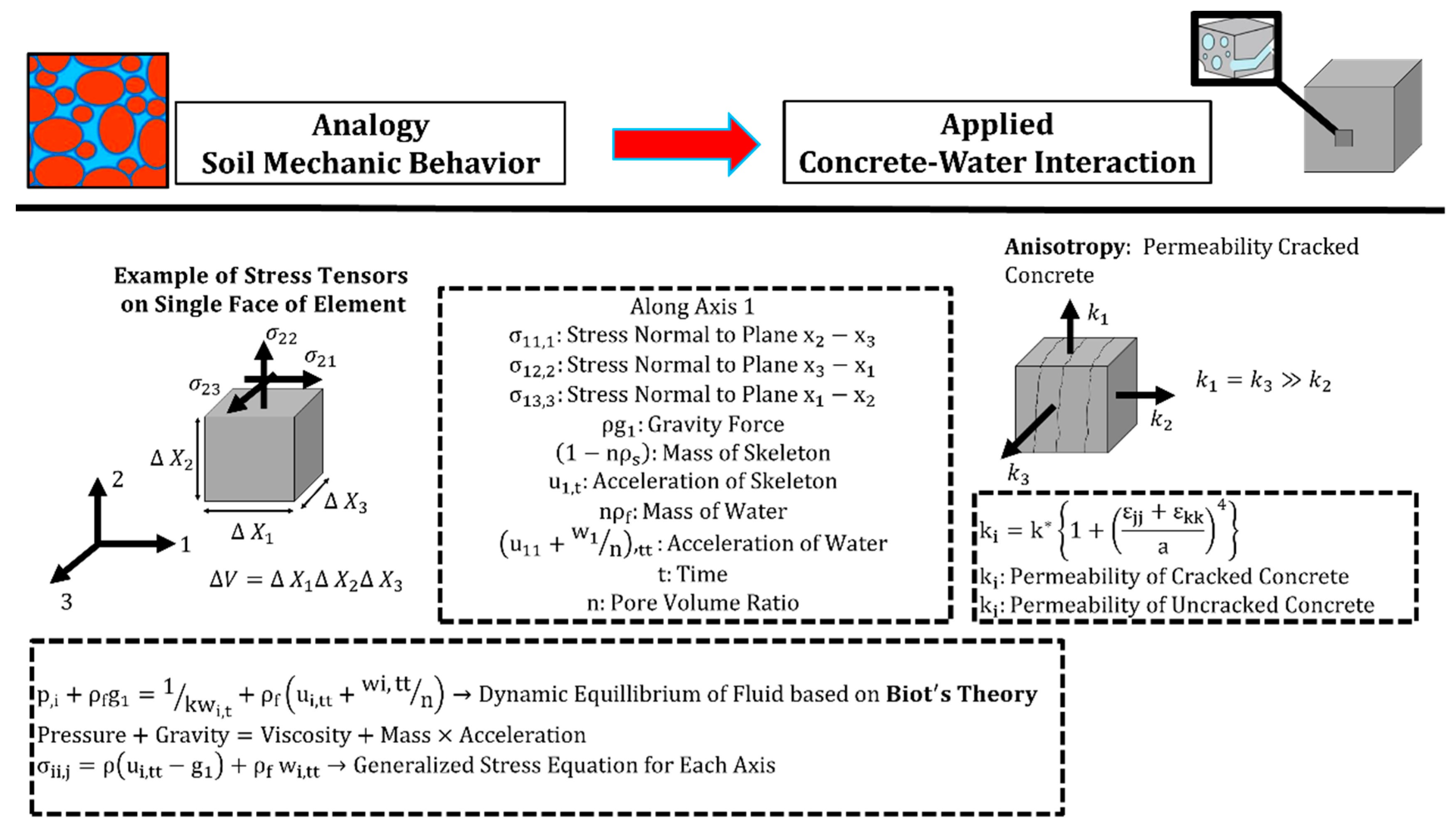
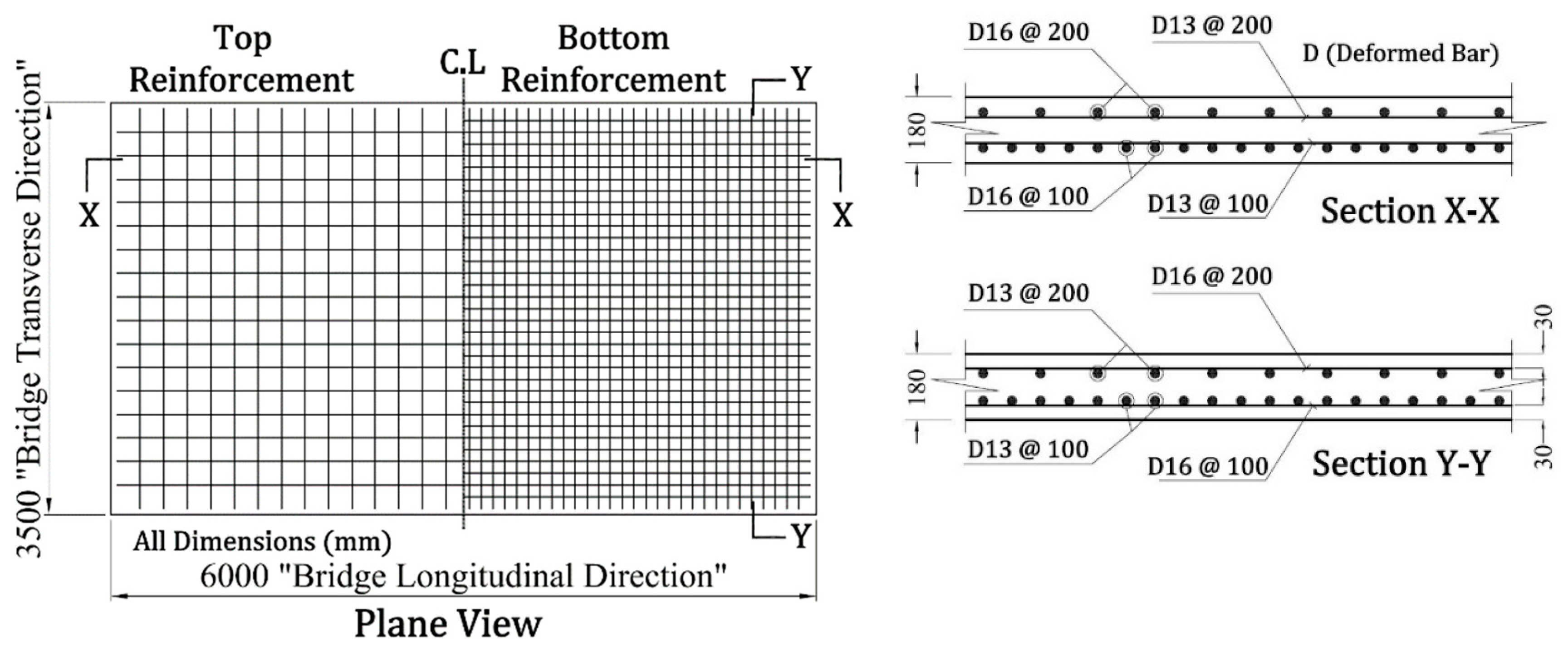
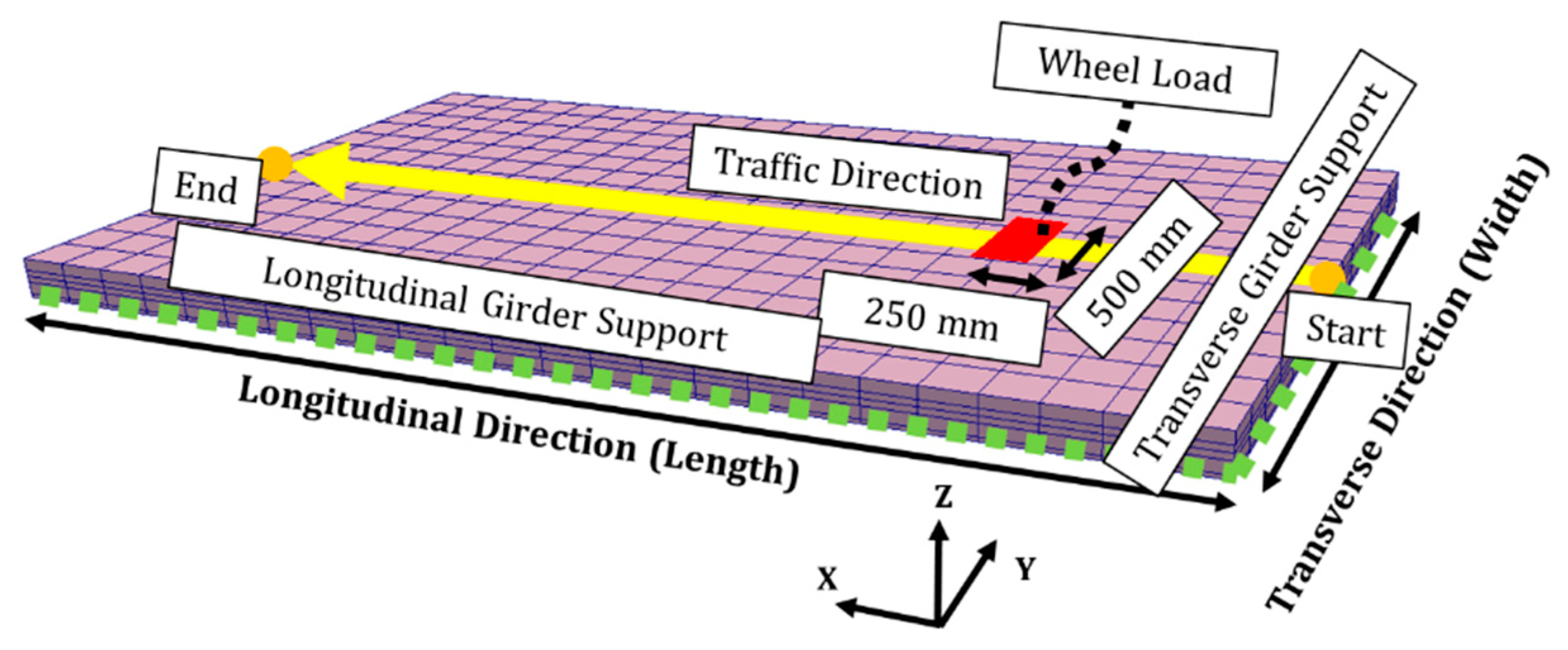
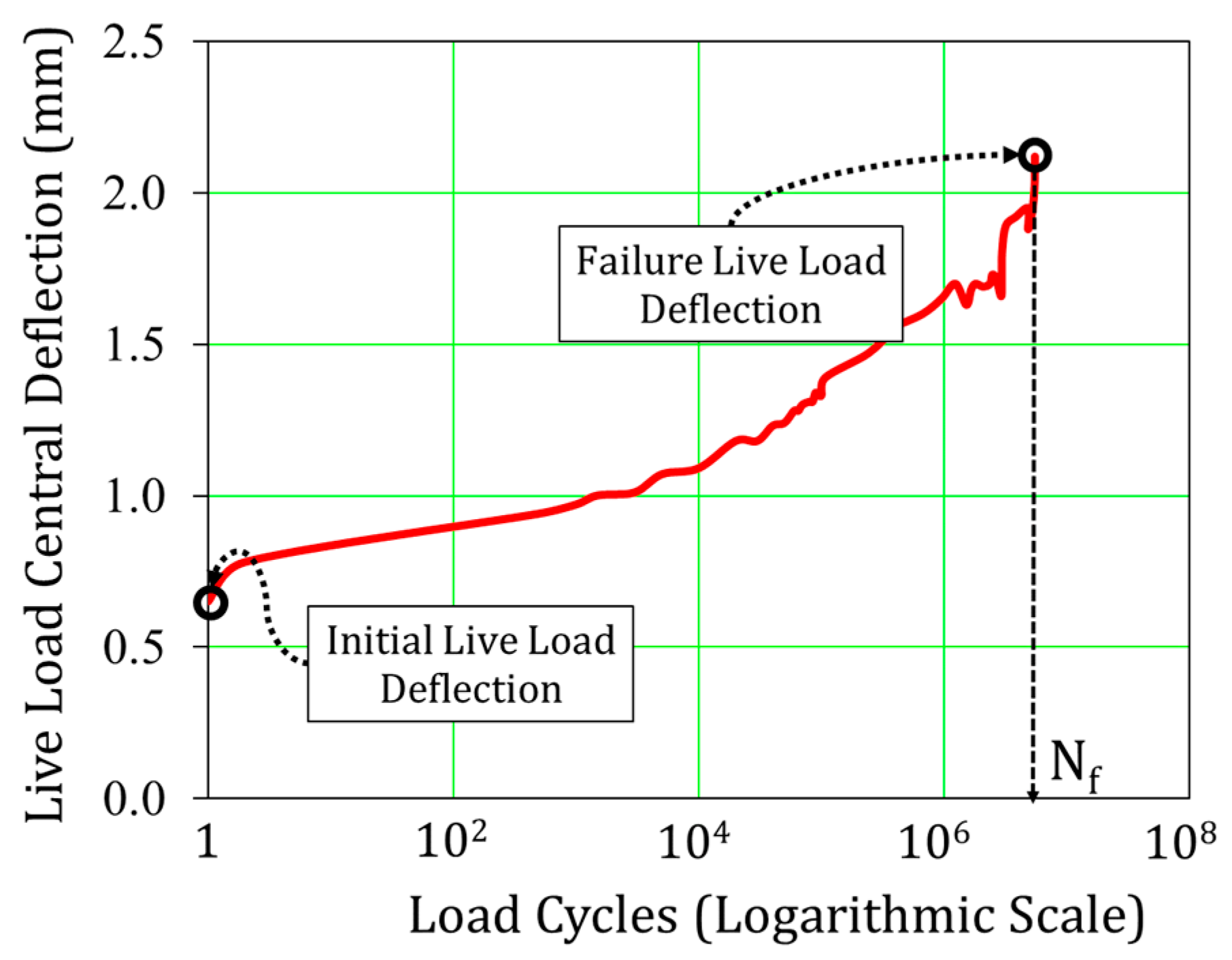
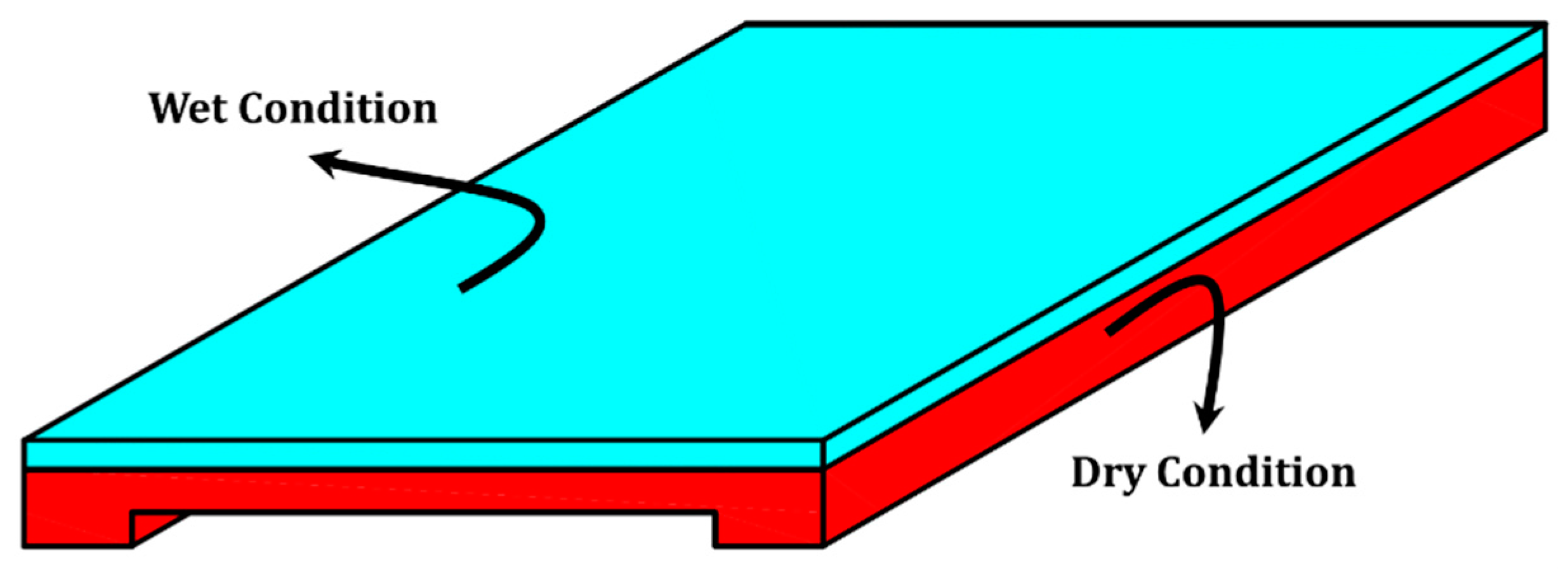
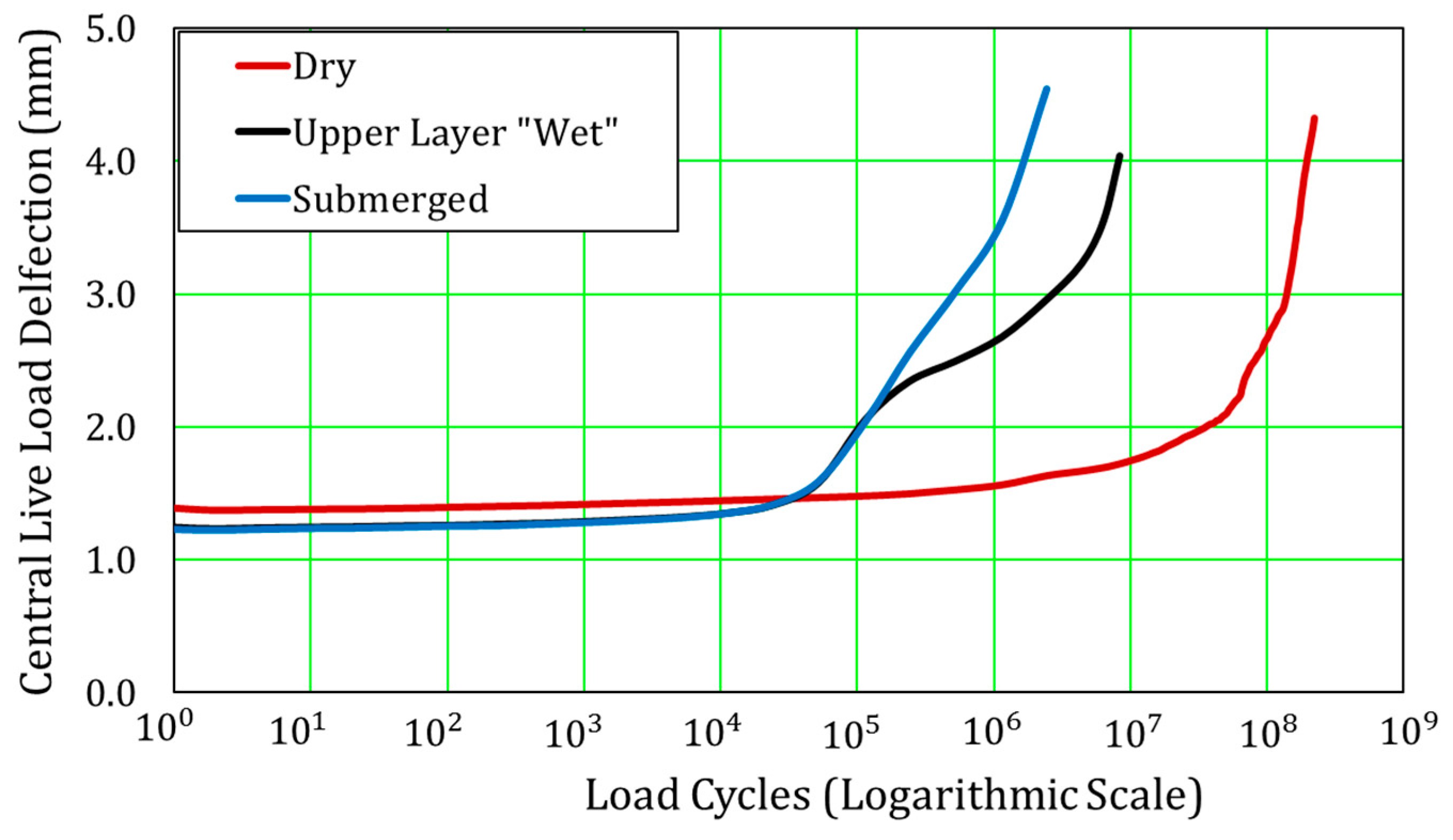
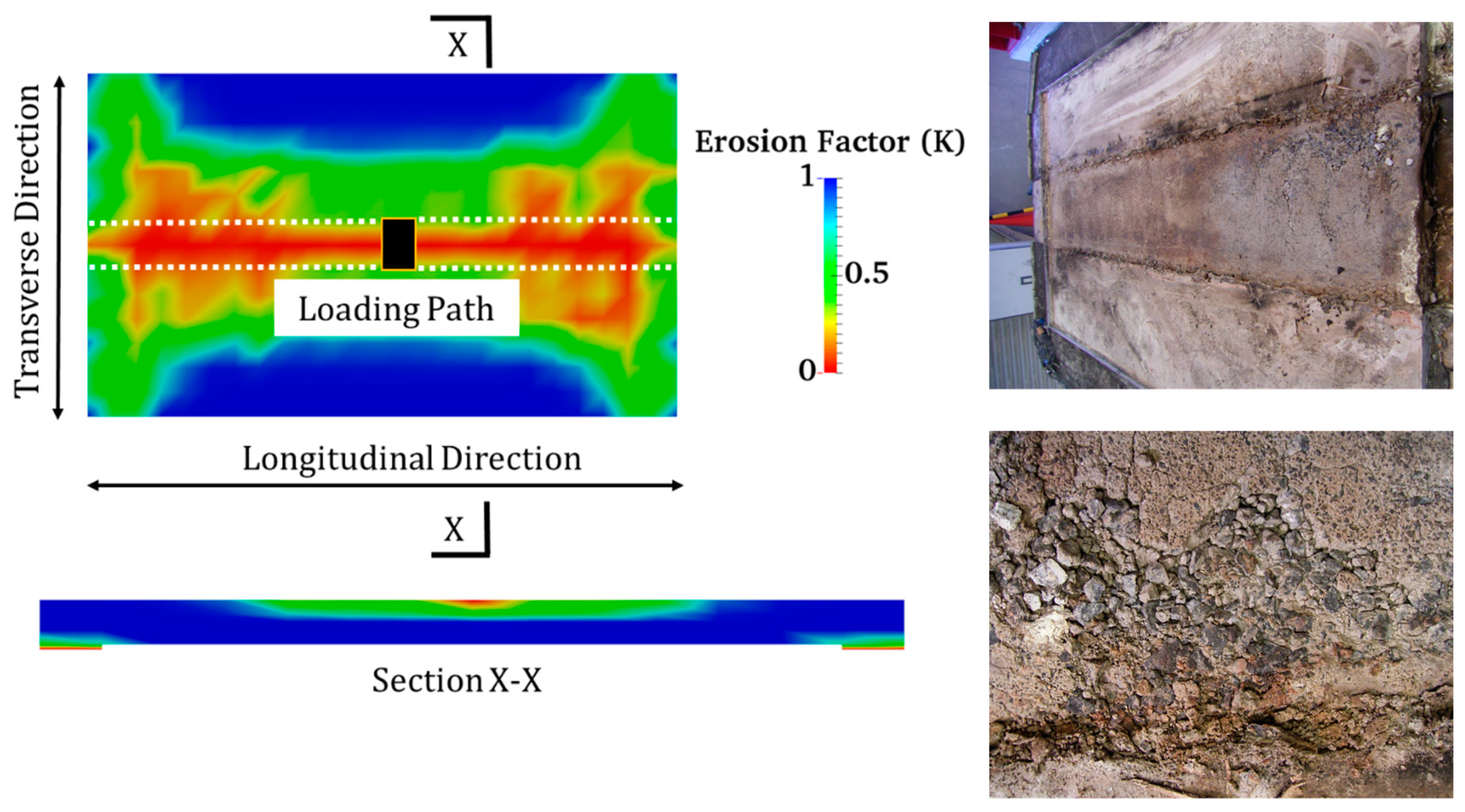
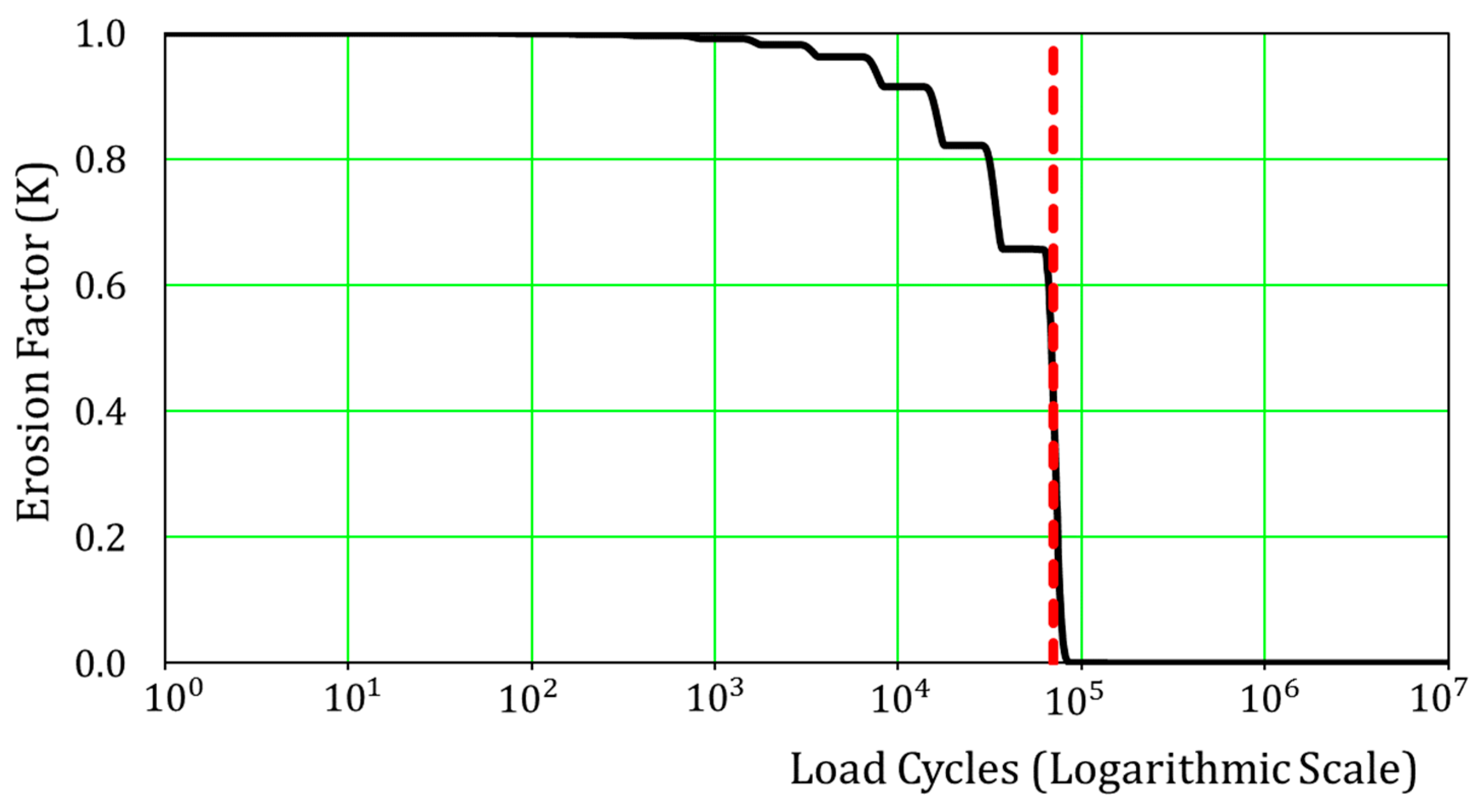
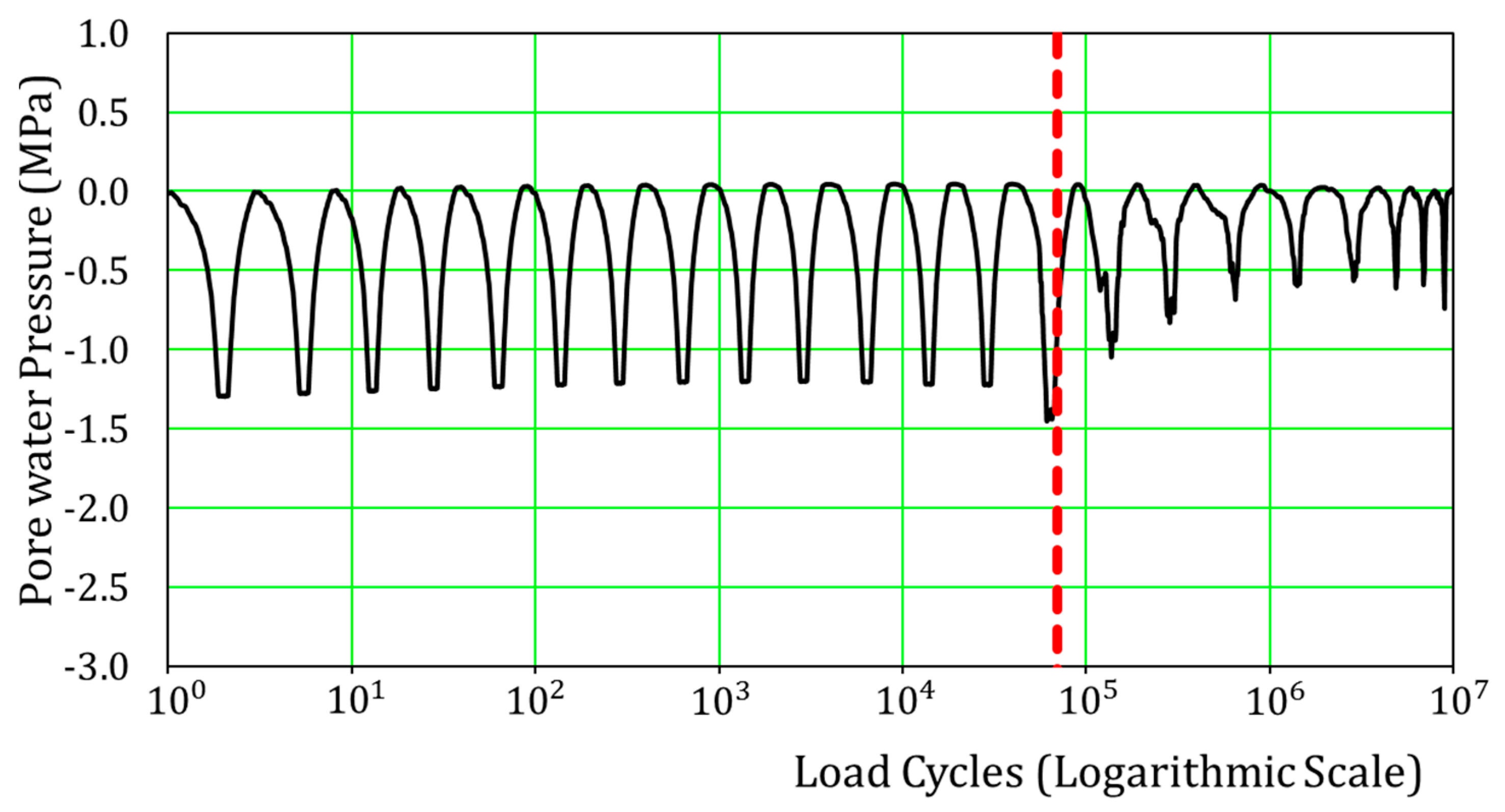
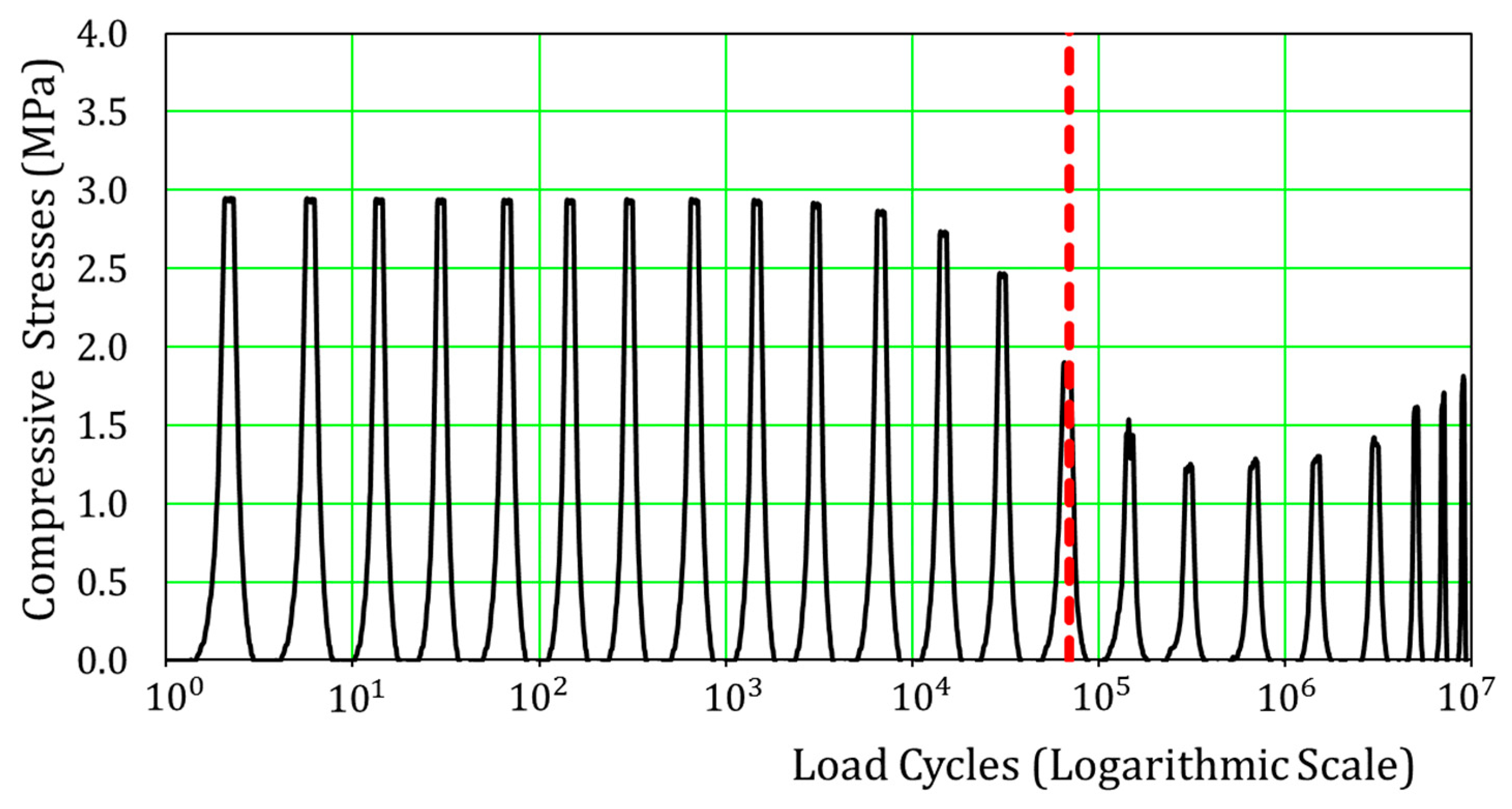
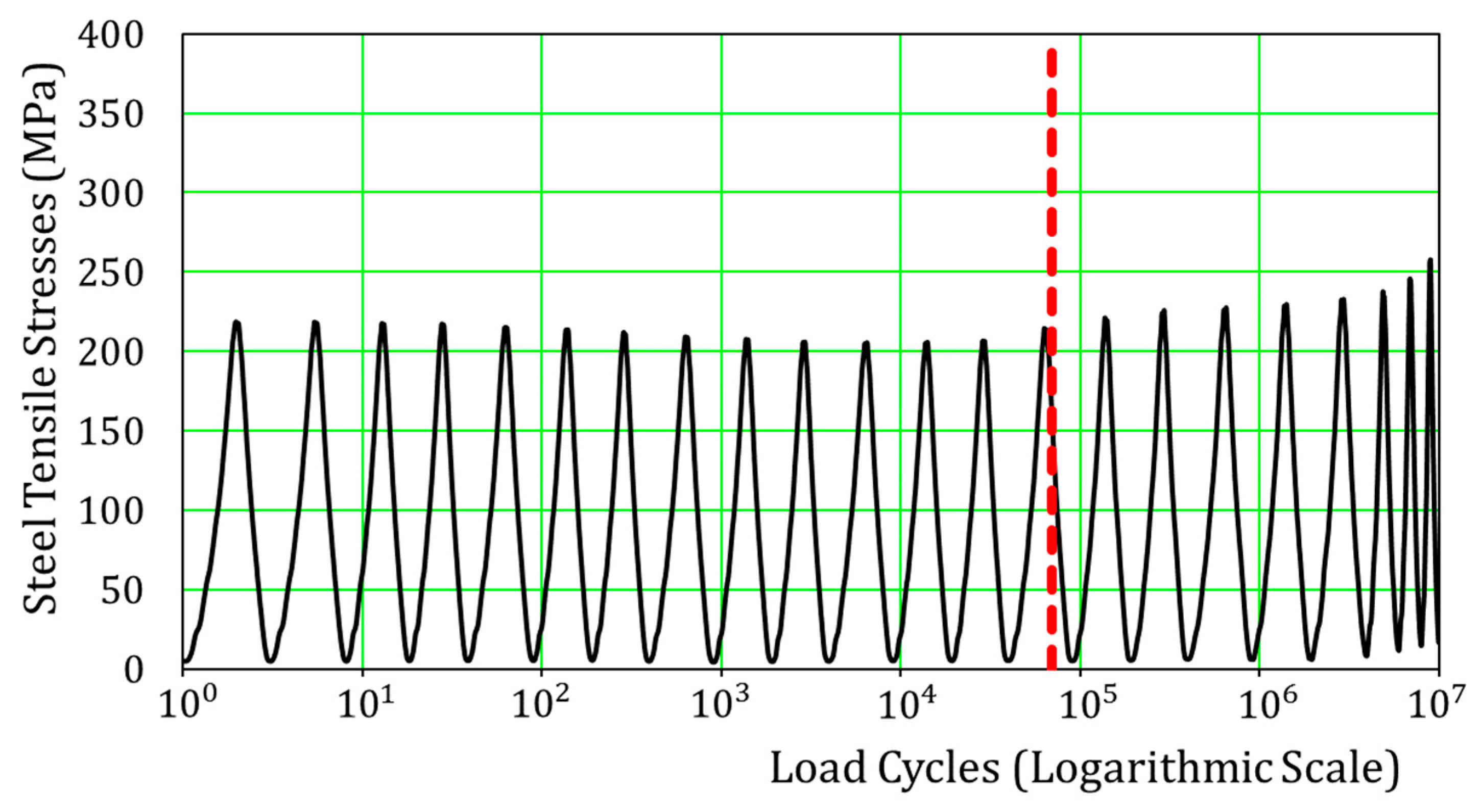
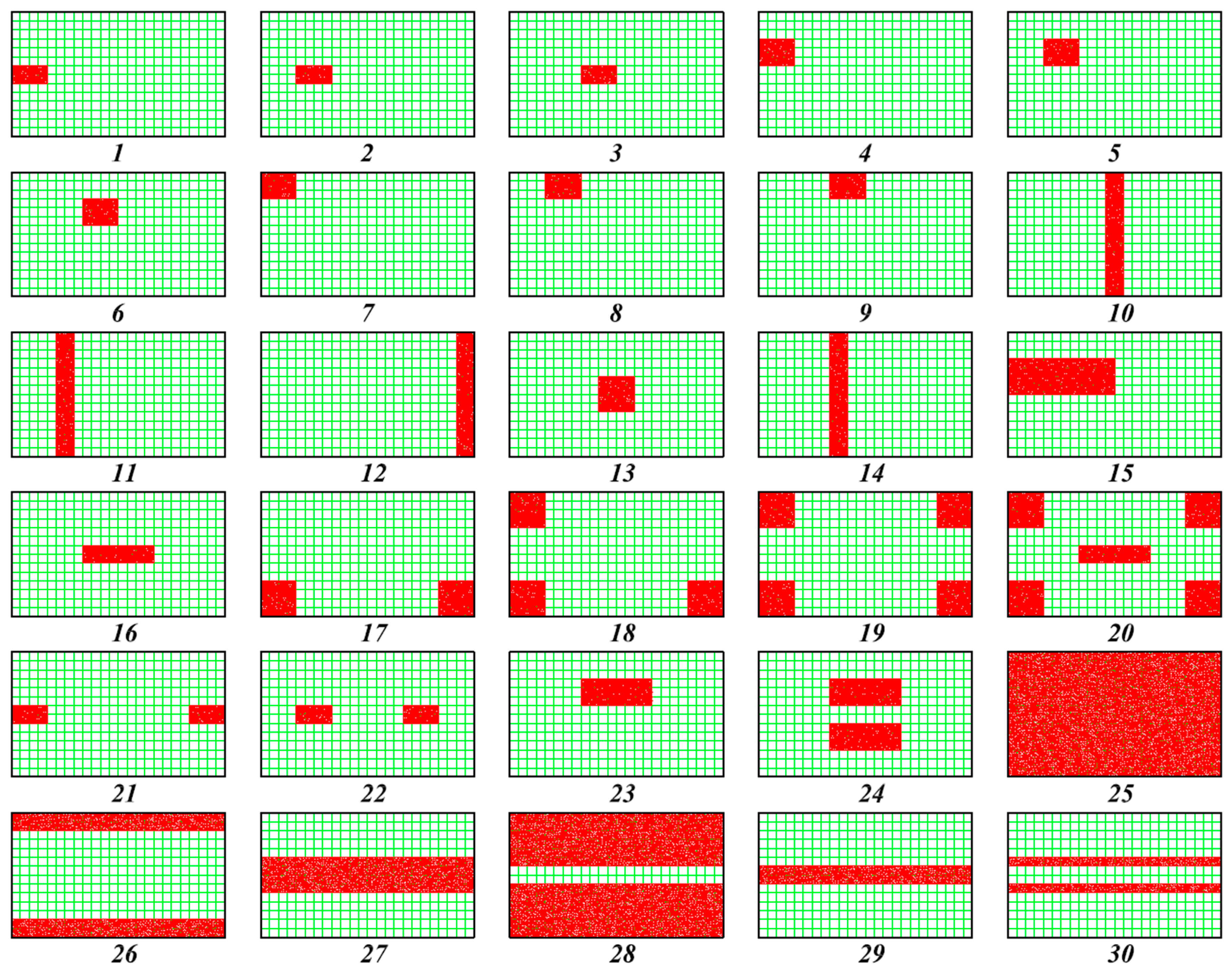
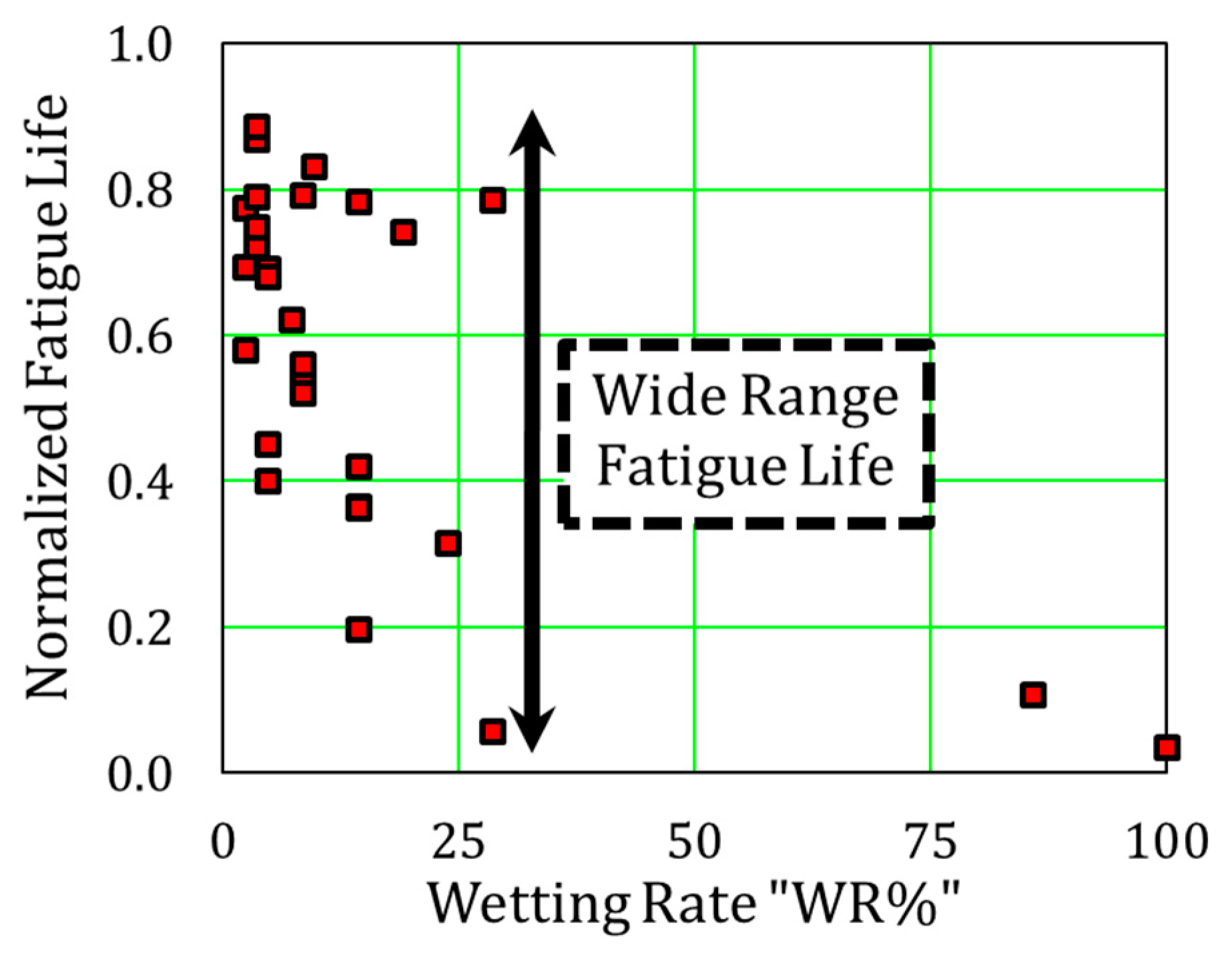

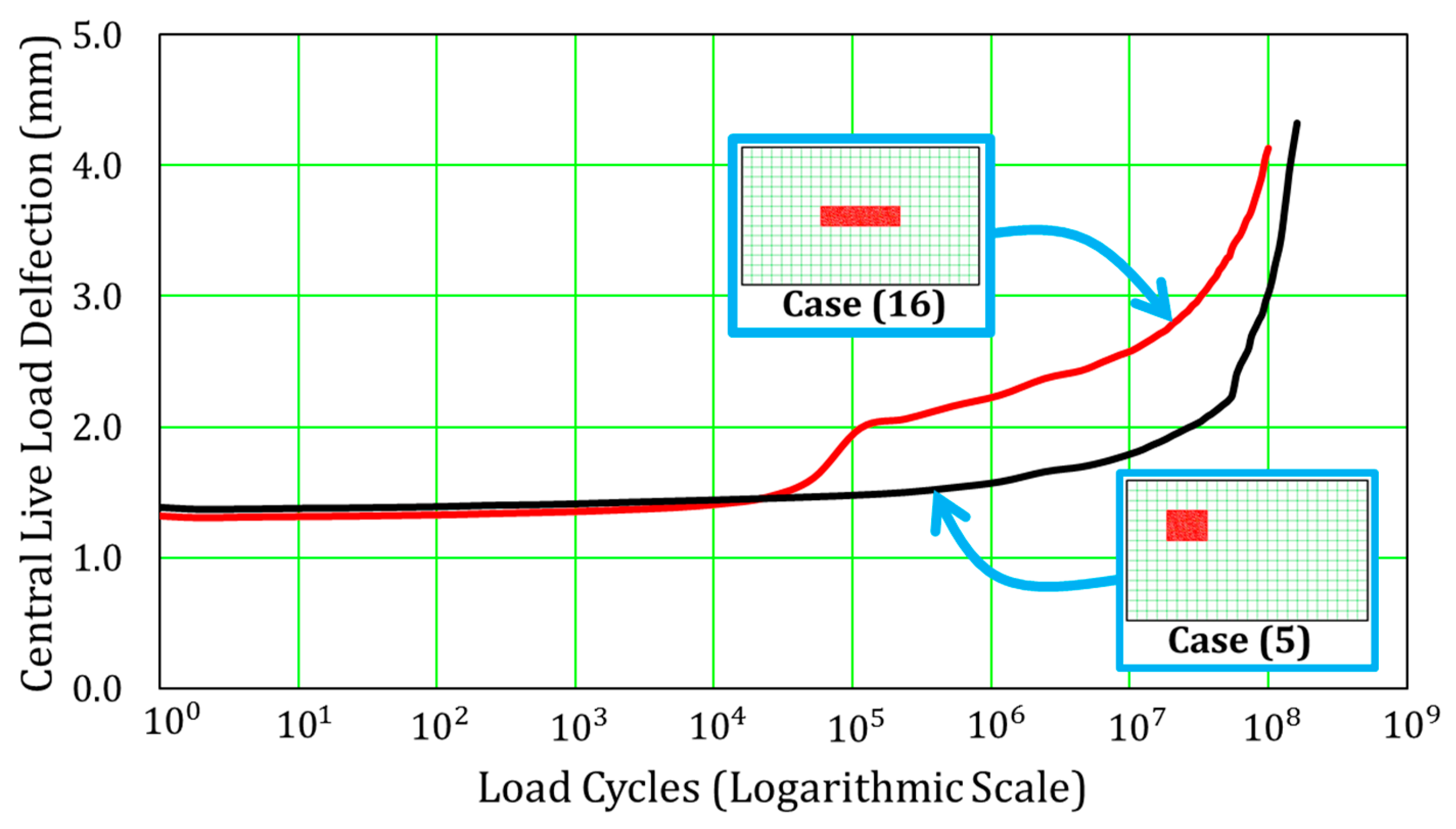
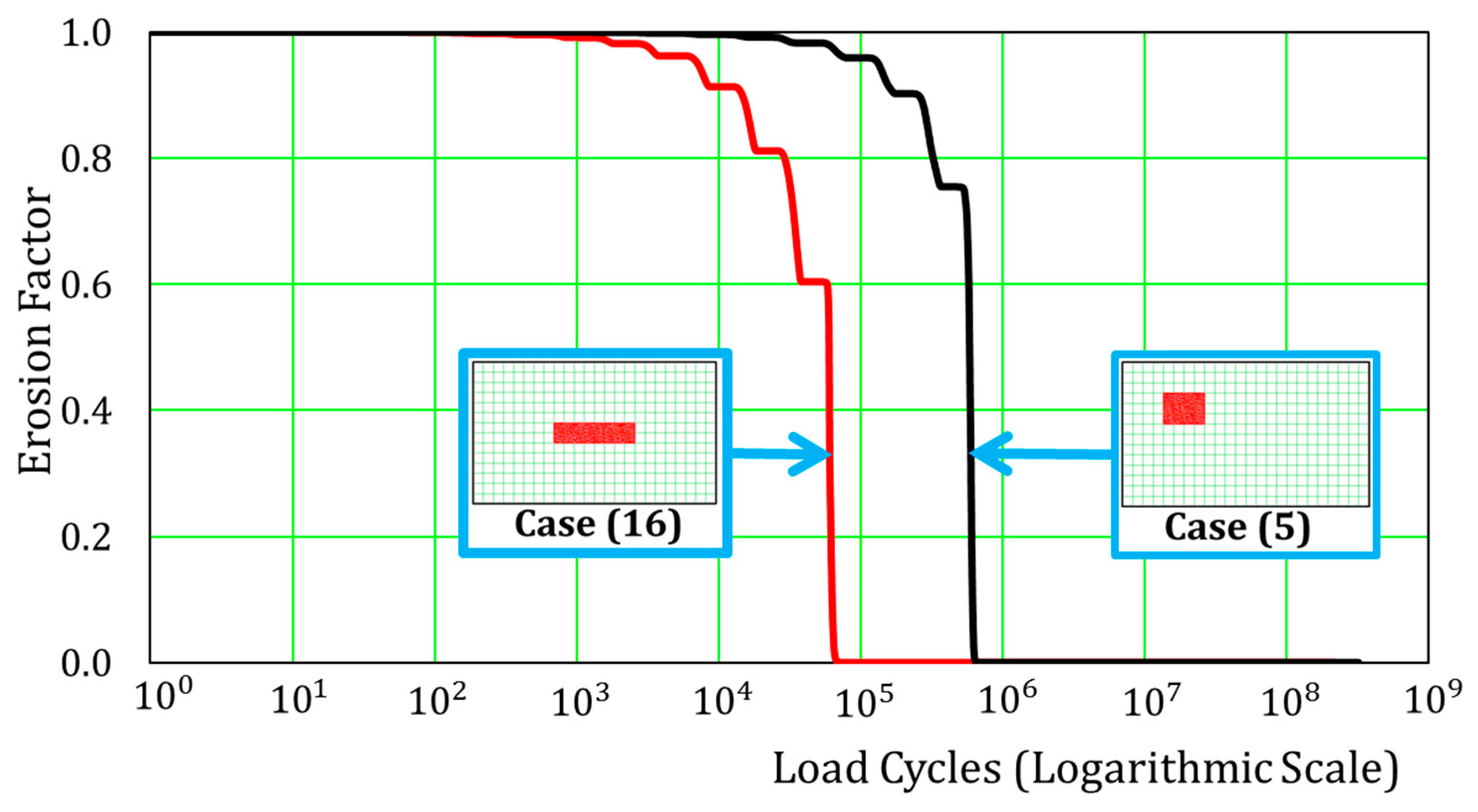
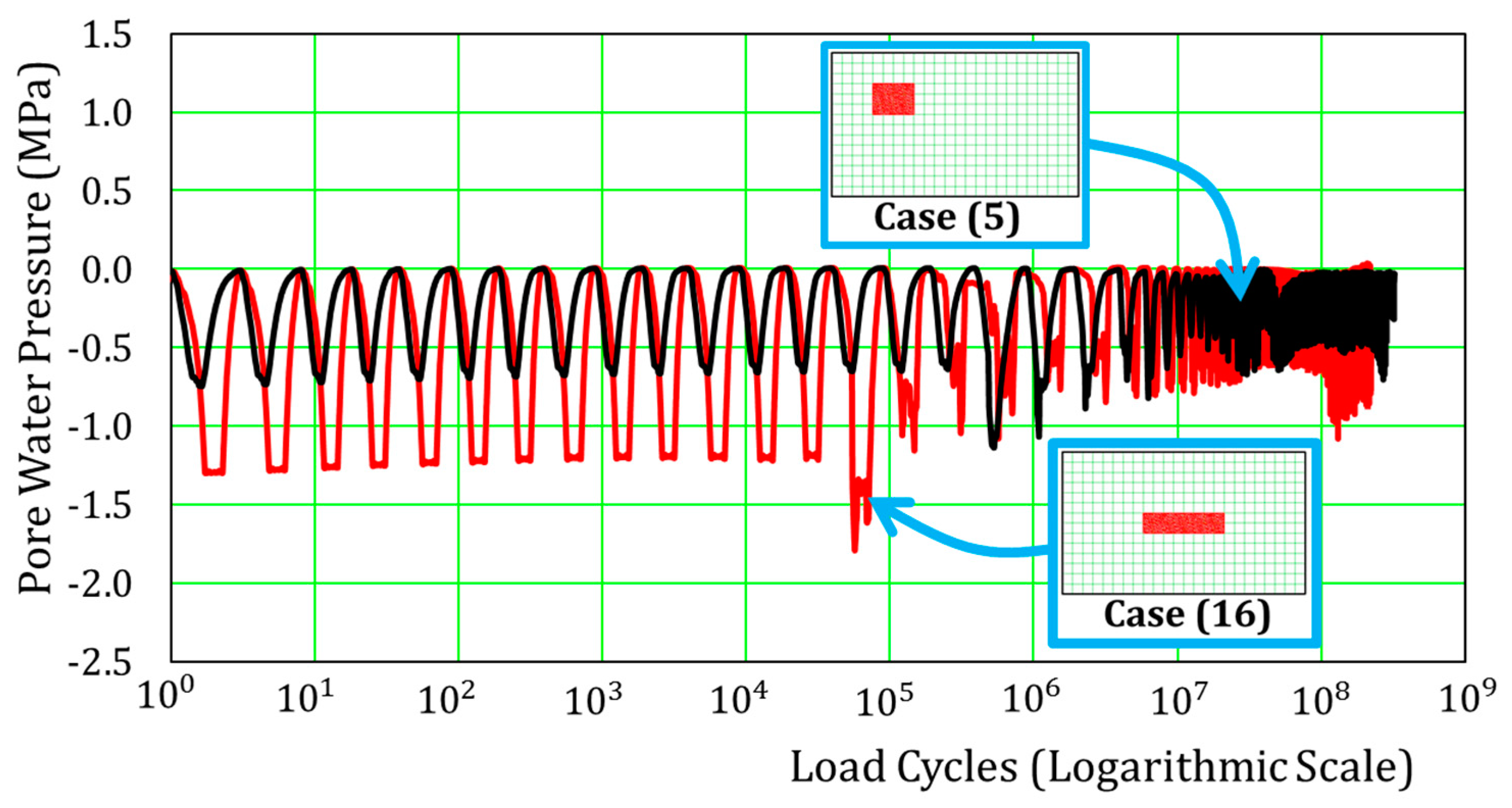
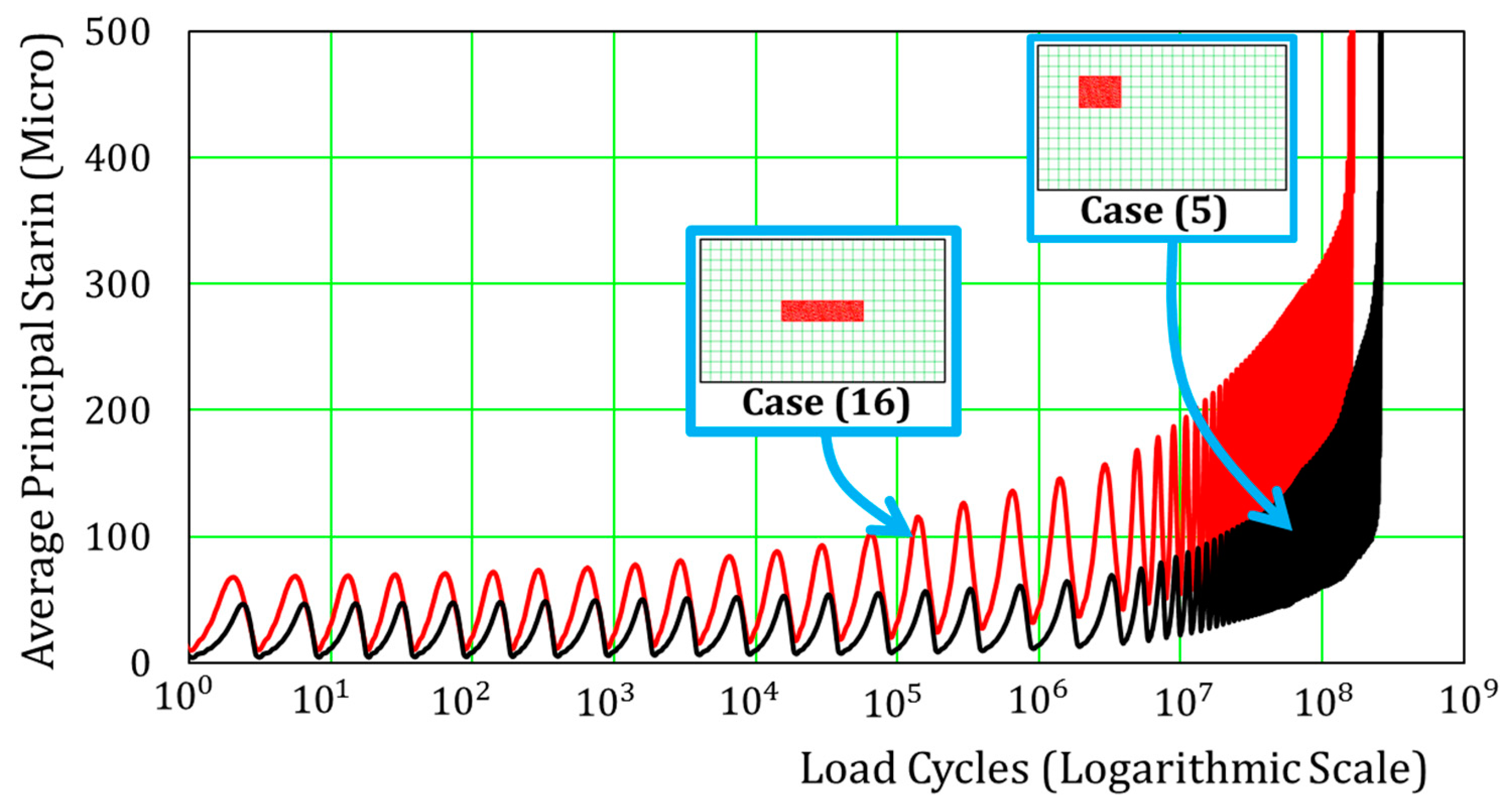
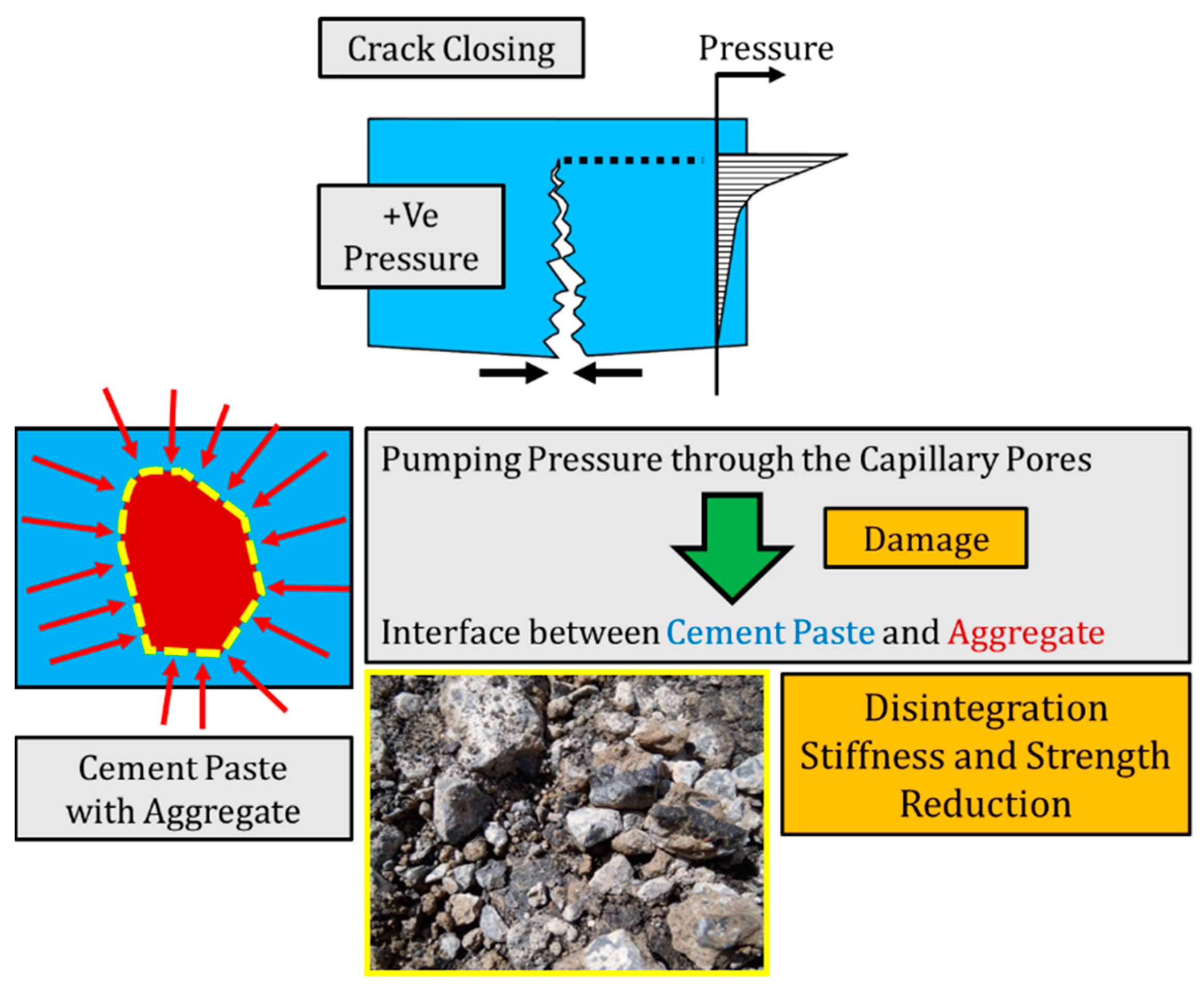

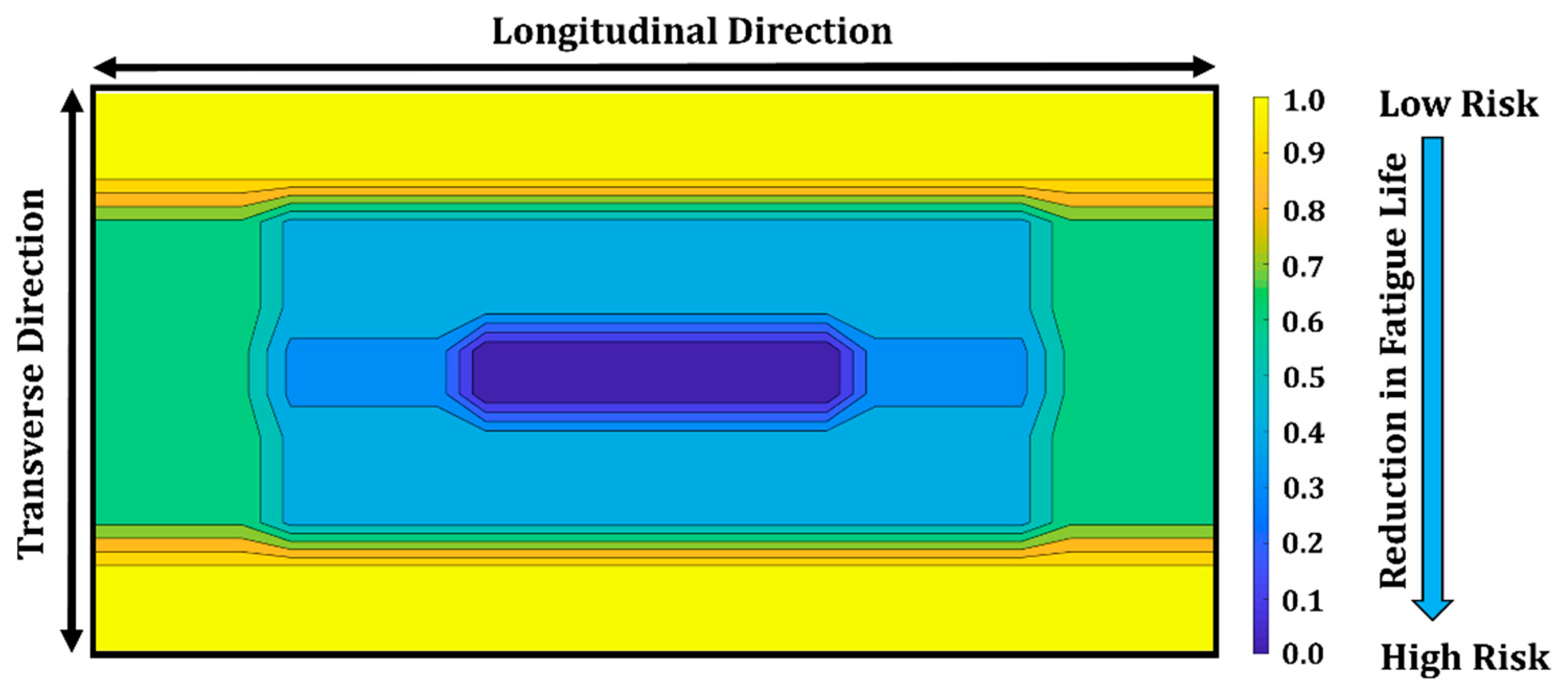
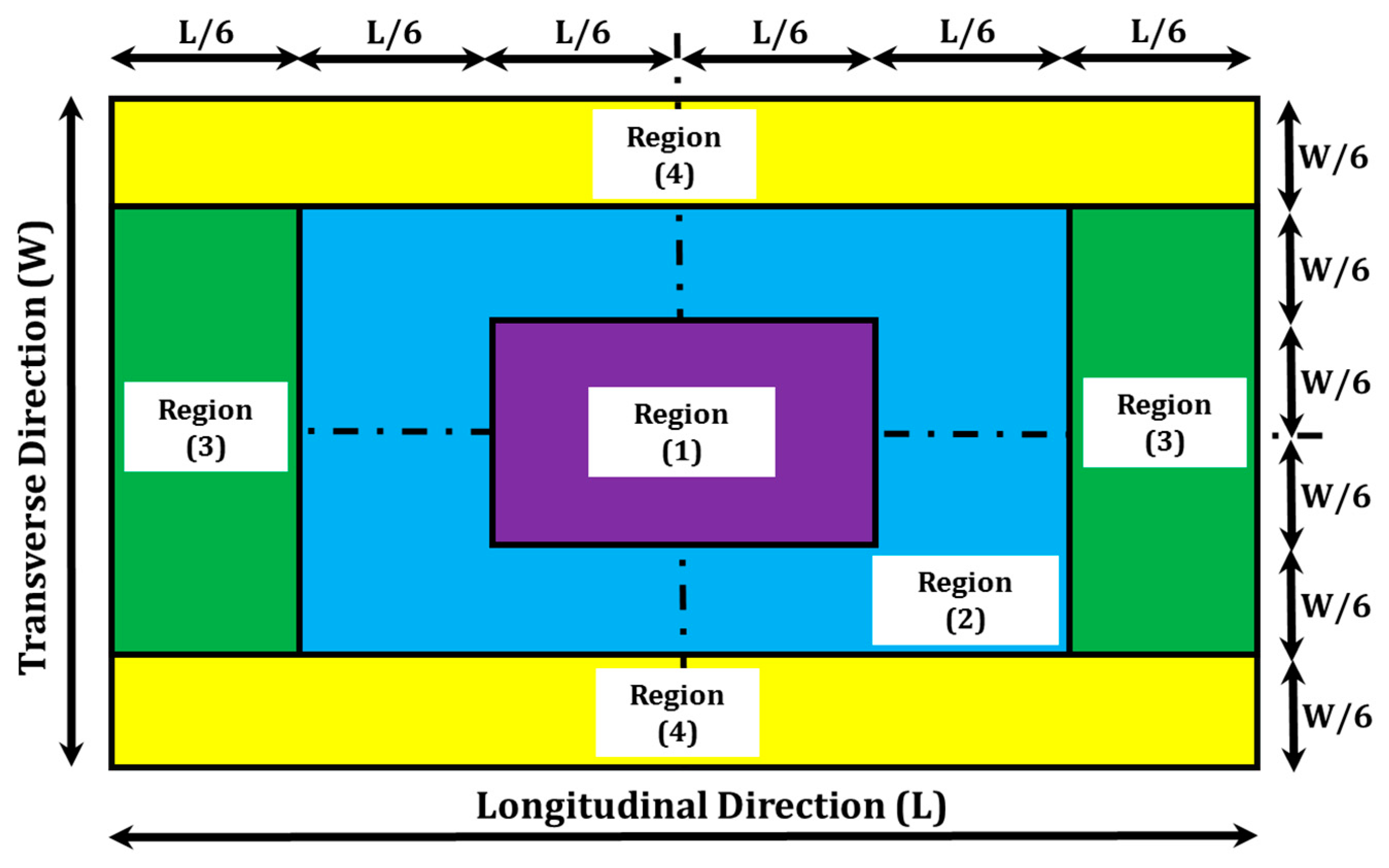
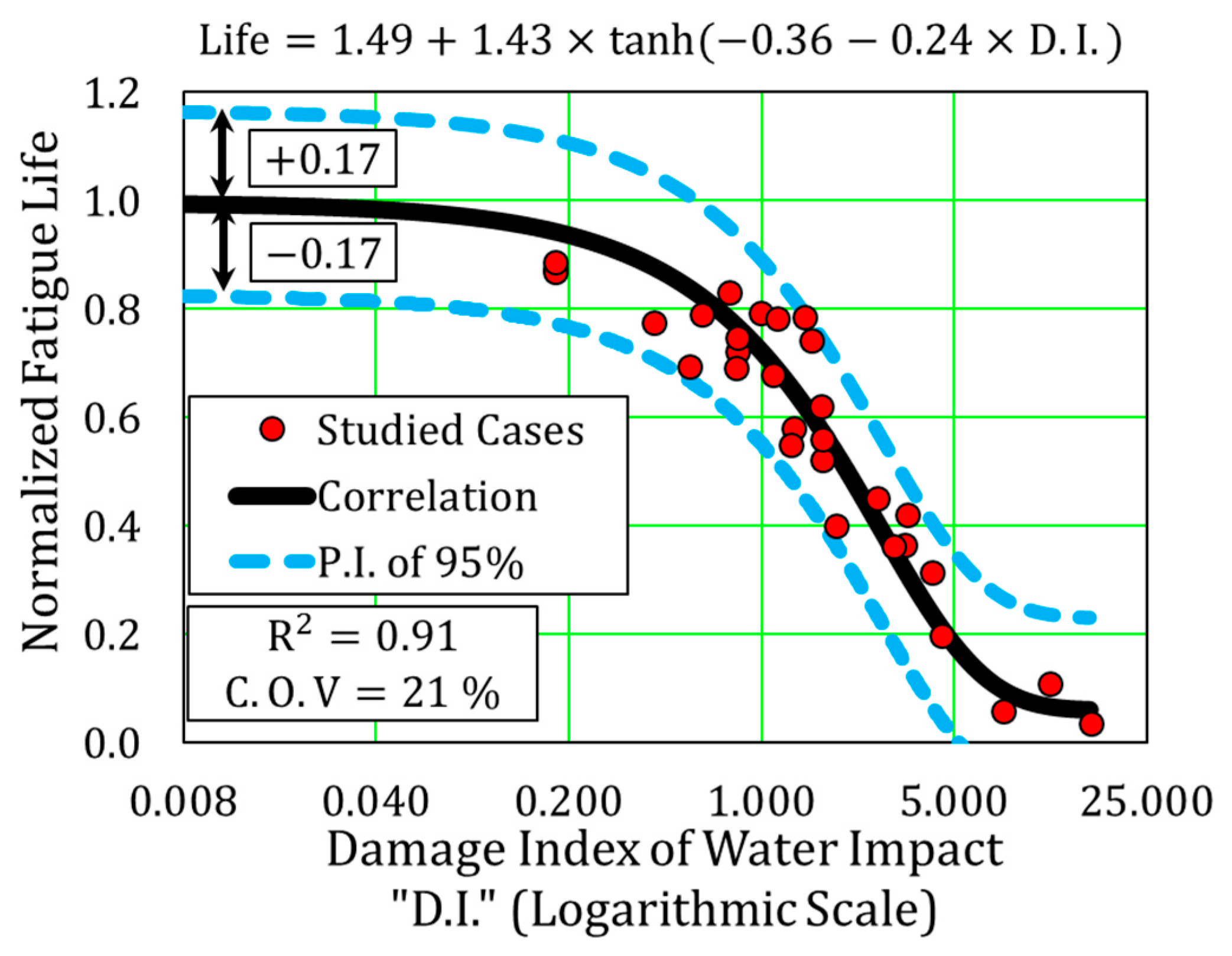
| Material Type | Concrete | Steel Reinforcement | |
|---|---|---|---|
| Young’s Modulus | N/mm2 | 24,750 | 205,000 |
| Compressive Strength | N/mm2 | 30 | 295 |
| Tensile Strength | N/mm2 | 2.2 | 295 |
| Specific Weight | kN/m3 | 24 | 78 |
| Case | Remaining Fatigue Life (Million Cycles) | Reduction in Life (Compared to Dry Case) |
|---|---|---|
| Dry Condition | 221.49 | 1.0 |
| Upper Layer (Wet) | 8.16 | 1/27 |
| Submerged | 2.93 | 1/75 |
| Case | Life “Million Cycles” | Normalized “Dry” | WR% | Case | Life “Million Cycles” | Normalized “Dry” | WR% |
|---|---|---|---|---|---|---|---|
| 1 | 171.7 | 0.78 | 2.4 | 16 | 99.8 | 0.45 | 4.8 |
| 2 | 153.8 | 0.69 | 2.4 | 17 | 184.0 | 0.83 | 9.5 |
| 3 | 128.3 | 0.58 | 2.4 | 18 | 173.5 | 0.78 | 14.3 |
| 4 | 174.9 | 0.79 | 3.6 | 19 | 164.5 | 0.74 | 19.0 |
| 5 | 160.0 | 0.72 | 3.6 | 20 | 69.7 | 0.31 | 23.8 |
| 6 | 165.7 | 0.75 | 3.6 | 21 | 153.1 | 0.69 | 4.8 |
| 7 | 193.6 | 0.87 | 3.6 | 22 | 150.6 | 0.68 | 4.8 |
| 8 | 192.6 | 0.87 | 3.6 | 23 | 137.6 | 0.62 | 7.1 |
| 9 | 196.5 | 0.89 | 3.6 | 24 | 81.0 | 0.37 | 14.3 |
| 10 | 115.5 | 0.52 | 8.3 | 25 | 8.2 | 0.04 | 100.0 |
| 11 | 121.7 | 0.55 | 8.3 | 26 | 174.0 | 0.79 | 28.6 |
| 12 | 175.7 | 0.79 | 8.3 | 27 | 13.1 | 0.06 | 28.6 |
| 13 | 88.8 | 0.40 | 4.8 | 28 | 24.2 | 0.11 | 85.7 |
| 14 | 124.2 | 0.56 | 8.3 | 29 | 43.6 | 0.20 | 14.3 |
| 15 | 93.1 | 0.42 | 14.3 | 30 | 80.6 | 0.36 | 14.3 |
| Case | Life “Million Cycles” | Normalized “Dry” | Normalization (0 and 1) |
|---|---|---|---|
| 1 | 171.7 | 0.78 | 0.65 |
| 2 | 153.8 | 0.69 | 0.35 |
| 3 | 128.3 | 0.58 | 0.00 |
| 4 | 174.9 | 0.79 | 0.68 |
| 5 | 160.0 | 0.72 | 0.45 |
| 6 | 165.7 | 0.75 | 0.55 |
| 7 | 193.6 | 0.87 | 0.94 |
| 8 | 192.6 | 0.87 | 0.94 |
| 9 | 196.5 | 0.89 | 1.00 |
© 2019 by the authors. Licensee MDPI, Basel, Switzerland. This article is an open access article distributed under the terms and conditions of the Creative Commons Attribution (CC BY) license (http://creativecommons.org/licenses/by/4.0/).
Share and Cite
Fathalla, E.; Tanaka, Y.; Maekawa, K. Fatigue Life of RC Bridge Decks Affected by Non-Uniformly Dispersed Stagnant Water. Appl. Sci. 2019, 9, 607. https://doi.org/10.3390/app9030607
Fathalla E, Tanaka Y, Maekawa K. Fatigue Life of RC Bridge Decks Affected by Non-Uniformly Dispersed Stagnant Water. Applied Sciences. 2019; 9(3):607. https://doi.org/10.3390/app9030607
Chicago/Turabian StyleFathalla, Eissa, Yasushi Tanaka, and Koichi Maekawa. 2019. "Fatigue Life of RC Bridge Decks Affected by Non-Uniformly Dispersed Stagnant Water" Applied Sciences 9, no. 3: 607. https://doi.org/10.3390/app9030607
APA StyleFathalla, E., Tanaka, Y., & Maekawa, K. (2019). Fatigue Life of RC Bridge Decks Affected by Non-Uniformly Dispersed Stagnant Water. Applied Sciences, 9(3), 607. https://doi.org/10.3390/app9030607





